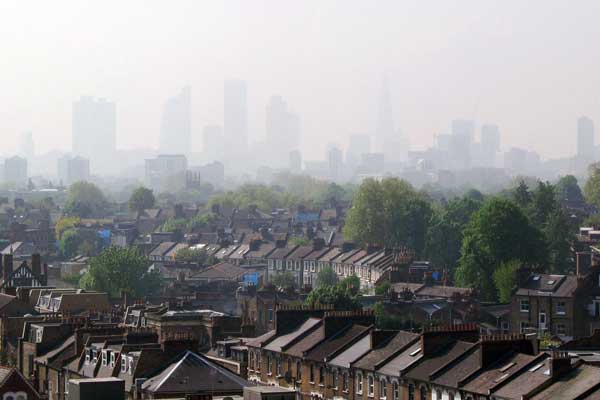
Urban grime discovery from University of Toronto captures world's attention
Published: August 26, 2015
Much to his surprise, University of Toronto chemistry professor James Donaldson found himself a media star this month, thanks to urban grime.
Donaldson has been studying urban grime for over a decade. He recently presented research at the annual convention of the American Chemical Society detailing how sunlight triggers the release of smog-forming nitrogen oxide compounds from the dirt that builds up on buildings and statues in cities.
Previously it had been thought that these compounds remained “trapped” in the grime.
The paper, co-written with PhD student Alyson Baergen and colleagues from Leipzig, Germany, has attracted intense media interest around the world, with hundreds of mentions in news outlets from Beijing to Delhi to Yellowknife, as well as popular websites such as WebMD, Yahoo! and Scientific American Online, and radio shows such as CBC Radio’s As It Happens. (See the BBC story. Read the RAI story. Read the RT News article. Read the International Business Times story.See the CBS News story.)
Donaldson talks with U of T News writer Terry Lavender about his research and how it advances our understanding of urban air pollution.
What exactly is urban grime?
Urban grime is a term we use to describe the stuff that deposits on urban surfaces. It is composed of thousands of chemical compounds, organic and inorganic, at least some of which arrive in the form of tiny particles.
What led you to research urban grime?
I first became interested in urban grime – specifically in its potential role as a substrate for atmospheric chemistry – about 10 years ago, in a collaborative project with U of T geography professor Miriam Diamond. At the time, she was studying the chemical composition of urban grime, in part to determine whether it would accurately reflect organic pollutant (such as PCB, brominated fire retardants, etc.) concentrations in the adjacent atmosphere.
Tell us about your own research.
For some time, my group used lab-generated proxies for the grime to study chemical reactions that might occur there but, in the last few years, we have started experimenting with grime we collect outside. Part of this work involves collecting urban grime and determining its inorganic chemical composition (sulfates, salts, nitrates, etc.) and part of it involves taking this collected grime into the lab to investigate its chemistry in a controlled fashion.
What have you found out?
Our work has shown that sunlight acting on urban grime very rapidly releases gas phase nitrogen oxides such as nitrogen dioxide (NO2) and nitrous oxide (HONO) back into the atmosphere, via the photo-degradation of nitrate anions (ions with negative charge) trapped in the grime. NO2 and HONO are very important players in urban atmospheric chemistry. NO2, a pollutant itself, is also the direct precursor to ozone (O3), another important pollutant. It is removed from the atmosphere via chemical transformation to a nitrate-containing compound, followed by dissolution in rain or fog drops, or deposition to exposed surfaces. Thus the nitrate is not just trapped by grime; it is also a constituent of it!
Why is this significant?
Our findings are significant because the nitrate in the grime was assumed to represent a final trap for atmospheric nitrogen oxides that had been deposited there. This re-emission might help to explain some recent findings of "too much" (that is, more that could be explained by known chemistry) HONO in urban atmospheres. It certainly will make us rethink our understanding of how air pollution works in urban environments.
What we have discovered is along the lines of a missing process in the understanding of urban air pollution chemistry. Rather than deposition being a final sink for the nitrogen oxide gases, they are re-emitted. But since they were present earlier as the gases, before they were lost to the grime, it is not quite right to say that this is a "new" source of the pollutants. This work has shown that we do not understand urban air pollution as well as we had thought.
Of course, no pollution in the first place is the best solution.
Can anything be done to mitigate the effect of sunlight on urban grime?
A flippant response is to say that, had there not been pollutants in the air, they would not have been lost to the grime in the first place, later to re-emerge! Seriously, though, at this time we are still exploring what kinds of chemistry occur with sunlight and grime, to understand fully the effects on local air pollution.
Does the amount of sunlight a city receives have an effect? What about the changing of the seasons, for example?
Good question! We are undertaking a long-term study in Toronto as a start to answering such questions. Stay tuned!
Your initial research was done in Leipzig and Toronto. Will you be looking at other cities as well?
Our initial laboratory work in Toronto showed that the nitrates are rapidly lost from grime, under illumination from sunlight. This motivated our year-long Toronto study of the grime composition, to explore whether there was some signature of this in the field data. It also motivated an intense, six-week campaign with colleagues at TROPOS – a Leibnitz institute for tropospheric research.
Leipzig was chosen because our colleagues at TROPOS have a measurement station in the centre of town, already measuring the composition of particulates, so it was very convenient to add a grime-sampling station. Its location in central Europe made it potentially interesting to compare what we saw there with what we are measuring in Toronto.
I am discussing with colleagues at Fudan University the possibility of setting up a similar experiment in Shanghai. I anticipate that we will be able to start such an experiment in 2016.
Your results seem to have struck a nerve. Are you surprised by all the media attention?
In a word, yes!


